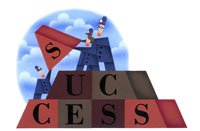How do undergraduate business students at Wharton depict and describe the essence of leadership? Since 2000, all Wharton freshmen have been required to answer that question through Images of Leadership, a project sponsored by Wharton’s undergraduate leadership program, led by director Anne M. Greenhalgh and associate director Christopher I. Maxwell.
From fall 2000 through fall 2003, Greenhalgh and Maxwell asked 1,918 freshmen enrolled in Management 100: Leadership and Communication in Groups to select or design an image that represented leadership, and then write a 100-word essay explaining why they selected that image. Each student’s response was posted to a secure website.
In an effort to understand students’ perceptions of leadership before they began instruction, the two directors then conducted a detailed, automated search of the information submitted in order to identify the most frequently used images as well as the nouns, adjectives and verbs students chose to portray leaders.
In a recent report called, Images of Leadership: The Story Emerging Leaders Tell, Greenhalgh and Maxwell discuss the students’ responses. First, the students selected what Greenhalgh and Maxwell called the “sort of images we might expect” — namely, images of Mahatma Gandhi, Martin Luther King, Rosa Parks, John F. Kennedy, Nelson Mandela, Winston Churchill, Franklin Roosevelt, Napoleon on horseback, George Washington crossing the Delaware River, Mother Teresa, Princess Diana, Confucius, Mayor Rudolph and New York City firemen after 9/11, and sports figures like Michael Jordan.
Many students, however, also posted unusual and even unique images of leadership. These include trees (leaders are grounded yet visionary); a sieve and funnel (leaders generate or collect ideas and get them into focus); a crew team (pulling together to provide leadership); silly putty (a leader must be flexible); a pillow (accommodating); a steering wheel (a leader provides direction); a chessboard (strategic qualities); and geese flying in formation (suggesting that leaders often work both separately and interdependently). Said Greenhalgh: “Flying geese are very popular images of leadership…. It’s representative of the fact that leadership is shared — one goose steps forward and another steps back.”
The next tier of leadership images used by the students, said Greenhalgh, are objects that reflect multiple, interlocking parts. These images illustrate that “we are in this together and we are interdependent,” and range from padlocks and clasped hands to charm bracelets and puzzle pieces.
Team Jordan
By analyzing the most frequently used essay words, Greenhalgh and Maxwell discovered that the undergraduate business students describe the “essence of leadership in plural, moral and inspirational language.” Translation? When it comes to “plural” language, Greenhalgh and Maxwell return to the images of charm bracelets, flying geese, crew teams and tall trees. “Plural is easy,” said Greenhalgh. “We don’t always have a lone figure, a solo person. In the overarching story, the students talk about leadership in plural ways. It’s not leadership as the ‘lone Marlboro man.’ When you point to the most frequently used words, the individual leader is always seen in the context of others, group, people, team. That’s what we mean by ‘plural.'”
Greenhalgh and Maxwell pointed to the popularity of retired basketball star Michael Jordan as an image of leadership. But leadership essays often have nothing to do with Jordan’s individual career statistics, and everything to do with how he elevated the performance of the entire team, another example of how students describe leadership in a “plural” context. “It’s not about the leader, but what the leader brings out in other people,” said Greenhalgh.
To understand the students’ use of “moral” language to describe leadership, the two directors analyzed the most frequently used adjectives. Across the board for both males and females, these include words like good, great, best, able and true. When it comes to “inspirational” language, the students were most comfortable with words that reflect a sense of possibility — the possibility to become, believe, achieve, create.
One essay, written by a male student, used plural, moral and inspirational language to describe Mother Teresa: “… Being a true leader, Mother Teresa was someone who was not afraid to do the right thing or motivate others to do so…. She went out into the world and dedicated her life to a worthy cause. Not many people would willingly give up the comforts of modern society and undergo a frugal lifestyle in order to help others Yet this marvelous woman did so and succeeded. Through her actions and dedications, she motivated many people to contribute to helping the poor of the world, when otherwise those same people would never have helped the poor in any way. Thus, Mother Teresa embodies what it means to be a leader. She helped when no one would and in so doing inspired others to do the same thing. Leaders are not made, they are born, and Mother Teresa showed the world that she was definitely one of those rare individuals who can be called a leader.”
While the study confirmed that male and female students agree on many word choices, Greenhalgh and Maxwell discovered some subtle, although important, differences between the sexes. Among their key findings:
- Female students show sensitivity to gender when selecting adjectives and nouns. For instance, given the choice between using his or her in essays to refer to leadership, males choose her nearly 12% of the time, while females use her roughly three times more frequently.
- For males, her ranks 10th in frequency; for females, her ranks 3rd. When it comes to nouns, male students more often choose gender-specific nouns like male while female students choose gender inclusive words like member, which can refer to males and females.
- The verbs used by males and females to talk about leadership action are largely transformational rather than transactional. Transformational verbs such as lead, make, follow, inspire, achieve, believe and become are more prevalent in the students’ essays than transactional verbs such as take, order and give.
According to Greenhalgh, transformational leadership reflects “leadership with the capacity to direct others to undertake new tasks, as opposed to transactional leadership, which we tend to associate with top-down hierarchies. Transformational leadership is more of a pull; transactional leadership is more of a push.”
To further explain the differences in the two leadership styles, Greenhalgh turned to one of the students’ favorite examples — Braveheart, a 1995 movie starring Mel Gibson as William Wallace, a commoner who unites the 13th century Scots in their battle to overthrow English rule. “He lifts up an entire army of men and inspires them to be willing to sacrifice their lives for freedom. Bringing up others and transforming others to a higher goal … leaving the world a better place, is at the heart of transformational leadership. This is very different from transactional leadership, which is basically, ‘Give me something in exchange.'”
The predominant use of transformational verbs by both male and female students surprised the Wharton directors. Previous research on this topic has clearly been divided into two camps: One suggests that women view leadership in more transformational styles, while men choose more transactional models; the second view suggests that any evidence that men and women engage in different leadership styles is overstated. Based on findings from The Images of Leadership study, Greenhalgh and Maxwell support the theory that men and women do not engage in different leadership styles as much as previously thought. While pointing out that males and females talk about leadership action in slightly different ways, the study confirms that male and female students “do not talk about the leadership action in a way that is gender stereotypic.”
Moral Leadership
Of the 1,918 freshmen students who participated in the study from 2000 to 2003, 62.9% were male and 37.1% female; 46% were identified as minority and 16% as international; the average age was 18. The vast majority of the images chosen by students came from the Internet, although a few students elected to generate or draw their own. All students were required to post their images and essays before the first class. Throughout the course, students referred back to the images and were asked to incorporate them into discussions and exercises that explored such questions as: Do leadership traits really matter? Which ones matter most? “The students all agreed that leadership traits do matter,” said Greenhalgh. “And from the data that they give us, we know that they are interested in moral leadership that is good, better, ideal.”
From the outset, Maxwell said, he and Greenhalgh hoped to achieve several goals through the Images of Leadership project: To gather perceptions of leadership before beginning instruction on leadership; to gather images of leadership as the basis for class discussion and exercises; to examine gender differences by subjects, qualities and actions; and to construct the overarching story “told by students as a whole and also by gender.”
Both Greenhalgh and Maxwell are acutely aware that their students’ views of leadership may not always mesh with the current realities of the working world.
The most obvious example of this? Citing statistics from 2002 that women accounted for “just 15.7% of top executives” that year, Greenhalgh and Maxwell point out that “we know from our study that emerging female leaders show a somewhat greater willingness to include both men and women as the subject of leadership. If our female students are seeking images of top male and female leaders in nearly equal measure, they will be disappointed….The challenge for the future is how to make both male and female transformational images of leadership a reality as emerging leaders enter the workforce.”
The students, Greenhalgh notes, “are all idealistic, without a question. And when we analyze the images and words they choose, I think another question might be, ‘Are they looking into the world and into the workplace and finding these images, or are these images that the students themselves aspire to?’ We don’t know the answer to that. That could be another study.”



